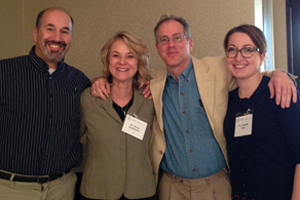AVMA Summit on Animal Welfare: Can You Hear Me Now? The ConversationDecember 12, 2013  HSVMA representatives at the summit included, from left to right: Drs. Gary Block, Susan Krebsbach and Barry Kipperman, and Cornell veterinary student, Michelle White. HSVMA In November, The American Veterinary Medical Association (AVMA) took a bold move forward when they hosted an intraprofessional dialogue about animals’ welfare and the veterinarians’ responsibilities to protect it. Entitled “Can You Hear Me Now? The Conversation,” the summit took place over two days in the backdrop of the AVMA’s headquarters in Rosemont, IL. A total of 150 selected AVMA and student AVMA members, reflecting diverse backgrounds from across the country—working on farms, in laboratories, for the government, in zoos, for animal protection organizations and providing services for companion animals—convened to participate in a series of presentations and roundtable discussions about animal welfare. The goal is to use the discussions from the summit to develop a strategy for ongoing dialogue within the veterinary profession about animal welfare. Among those selected to be a part of this exchange of ideas were several representatives from the HSVMA: Gary Block, DVM, MS, DACVIM, HSVMA Board member, Barry Kipperman, DVM, DACVIM, HSVMA Leadership Council member, Susan Krebsbach, DVM, HSVMA Veterinary Advisor, Michelle White, veterinary student and former HSVMA Student Chapter president at Cornell University College of Veterinary Medicine, and Lee Schrader, DVM, DACVIM, HSVMA member. Dr. Kipperman summed up the event by saying, “The meeting hosted numerous esteemed speakers discussing the breadth of welfare issues involving all types of animals. Workshops were included to use guidelines for determining solutions to welfare problems.” Lectures Address How Welfare Decisions are MadeThe first day of “The Conversation” provided foundational lectures on the scientific, social, political and legal aspects of how and why animal welfare decisions are made. When famed ethologist Dr. Ian Duncan gave his presentation “What is sentience and why do we care?,” he noted that, ironically, despite scientific and common-sense acceptance for animal sentience and feelings, for much of the 20th century scientists have eschewed any study of animal feelings, thoughts or emotions. Dr. Janice Siegford, assistant professor in the Animal Behavior and Welfare Group at Michigan State University whose research emphasizes assessing welfare in animals used for production, gave a presentation on “How do we define a scientific evaluation of an animal’s welfare?” Her opinion was that good animal welfare represents good quality of life from the perspective of the animal. A philosopher from the University of Copenhagen in Denmark, Dr. Peter Sandoe, gave a presentation entitled, “Welfare in an ethical and social context—from farm to family.” He concluded that scientists who believe that animal welfare science and ethics can be separated are wrong. Ethical statements guide action in a way that factual statements do not. In addition to these presentations, there were several others on the changing attitudes toward animals and their welfare and assuring animals’ good welfare, as well as challenges for veterinarians in both of these areas.. Group Discussions Focus on Welfare DilemmasThe second day centered around facilitating dialogue and roundtable discussions considering welfare-related dilemmas affecting animal uses across the veterinary profession. Many of the attendees found these exercises particularly beneficial. As stated by fourth year veterinary student Michelle White, “In the breakout sessions, consisting of groups of around 10 veterinarians representing diverse areas of the profession, we were challenged to come to a consensus regarding which decisions were in the overall best interest for the group of animals in question. I expected the wide range of opinions that were brought to the discussions. What I didn't expect was the open-minded, supportive discourse that allowed my group to reach a single preferred option for each exercise. This made me optimistic for a future in which our profession can have a unified voice that speaks to improve the welfare of all animals.” The focus on animal welfare, in America and abroad, has perhaps never been stronger or received more media attention. It is natural that the veterinary profession should take a leadership role in this area. As a matter of fact, this is one of the reasons that the HSVMA was formed over five years ago. It is very encouraging to see a large organization like the AVMA to seemingly not only embrace this concept but also facilitate a forum—a start—for its veterinarian members to become leaders on animal welfare issues. Dr. Gary Block probably put it best when he said, “Although I have been a frequent critic of the AVMA's lack of leadership regarding animal welfare issues, the AVMA should absolutely be commended for organizing this conference. Rather than recruiting speakers who simply parroted AVMA policy and dogma, I was impressed with the fact that many of the presentations challenged the audience to re-evaluate how we as veterinarians need to assess and critically evaluate animal welfare from the animal's perspective. This is, in my opinion, a sea-change in welfare science which historically used only empiric, quantifiable data (fertility, feed conversion, morbidity, etc.) to assess animal welfare.” |
